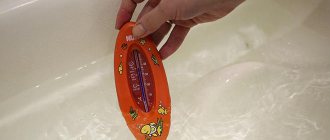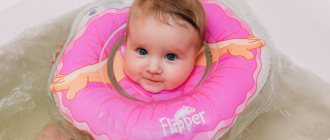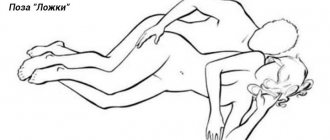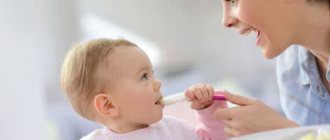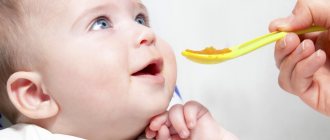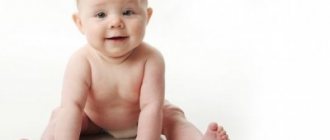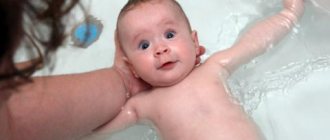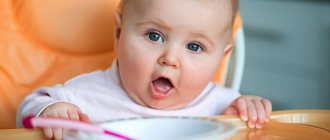What air temperature should be in the bathroom when bathing a newborn?
The “bath” procedures have come to an end.
They don't always end without tears. For various reasons, a baby may cry or be capricious after bathing. What should mom do? First of all, do not continue the care procedures after the bath, but hold him in your arms, walk around and calm him down. You can even rock him and feed him if he doesn’t stop talking for a long time. But try to do this so that the baby does not fall asleep, because it happens that a newborn falls asleep even while bathing.
Secondly, put it on the changing table, dry it and treat any wrinkles or redness with baby cream. Then put on a diaper and a clean romper. Don’t forget about the cap, because after bathing the baby’s head is warm.
Thirdly, feed the baby. If the bathing was successful, then during feeding he will already begin to doze off and gradually fall soundly and sweetly into sleep.
Finally, a few words about the benefits of bathing for a newborn. Regular water procedures not only ensure hygiene and cleanliness, but also develop motor skills, relax muscles, relieve pain from abdominal colic and strengthen the baby. Being close to parents while bathing evokes only positive emotions in the little one.
Many young mothers do not know what temperature the water should be for their baby. It is important to start bathing with a comfortable bath, then water procedures will subsequently evoke only pleasant emotions in the baby.
. This is the most comfortable indicator for a baby.
While in the womb, the child was surrounded by amniotic fluid, which had a temperature of 37-38 degrees. Therefore, at first the bath should be appropriate. This temperature is beneficial for the skin and promotes rapid healing of the umbilical wound.
Then it can be gradually lowered to 30-32 degrees. This is done so that the baby gets used to the changes. It is recommended to alternate temperature conditions. This will contribute to the strengthening and sustainable development of the baby.
The temperature in the room in which the child sleeps and plays is also important. It should be at 22 degrees. The temperature regime is selected based on the purposes of water procedures. For example, during the day you can bathe your child in a bath at a temperature of 30 degrees. This is a low, but quite comfortable indicator.
Such water will not allow the baby to relax. He will actively move his arms and legs. Cool water stimulates blood circulation and tones. The heart begins to contract more actively.
This helps the organs receive more nutrients, activates metabolism, and increases resistance to infections.
In the evening, it is recommended to bathe the baby in water at a temperature of 35-37 degrees. This bath will give a relaxing effect. Therefore, the child will sleep peacefully and soundly. Adults will find a temperature of 37 degrees cool.
But the skin of newborns is more delicate and sensitive. Therefore, such water will be comfortable. You need to bathe your baby every day. The optimal duration of the first procedure is no more than 3-4 minutes. Therefore, there is no need to worry that the water will cool down and the baby will freeze.
In a few minutes the temperature can drop by 1-2 degrees. This will not harm the baby. The rinsing water should be 1-2 degrees lower than the water used for bathing.
Gradually the duration of water procedures is increased to 15 minutes. At one month of age, a baby can be bathed at a temperature of 30-32 degrees for about 20-25 minutes.
Over the course of 30 days, the temperature is raised to 28-30 degrees, and the duration of the procedure is up to half an hour. An optimal microclimate should be created in the bathroom so that it is not too hot or stuffy. The ideal air temperature is 25 degrees.
When bathing a newborn, not only the temperature of the water plays a key role, but also the air temperature in the bathroom itself. The best option is if the temperature is kept between 24 and 26 degrees. If you are hardening a newborn, then the air temperature in the bathroom during bathing may be lower: 21 – 23°. It is not recommended to lower the temperature in the room below 21.
Many parents believe that for bathing the optimal temperature in the bathroom should be higher than that in the newborn’s room. However, it is not. The baby gets used to the temperature regime, so staying in a hot room may cause him to start freezing under normal conditions in his room.
At what temperature in the room to carry out water procedures and what temperature of water to choose to bathe a newborn, parents, after recommendations received in the maternity hospital, decide for themselves. However, remember that it is important not to overdo it with care: overheating affects the baby much worse than coolness.
The first bath of a newborn
A newborn baby's skin is excessively delicate, and heat production is not yet at the proper level, and the child quickly warms up or freezes, but cannot yet tell about it.
If you take too hot water for bathing (more than 37ᵒC), the child may overheat in it, and also, hot water puts a strain on the heart, the pores on the skin also expand, and infections can get inside.
In cool water suitable for bathing a child (less than 34ᵒC), he will freeze and will not enjoy it. In addition, you can catch a cold in your child’s bladder, and then he will cry when urinating.
It is advisable to spend the first bath of a small child in water at 37ᵒC; the newborn is accustomed to it, because in the mother’s stomach, the amniotic fluid in which he developed was the same temperature. In addition, a child is discharged from the maternity hospital with a wound on the navel that has not yet completely healed, and at this water temperature the umbilical cord will heal faster.
For the first 2 weeks, the baby will have to be bathed in boiled water, again because of the umbilical cord wound. You can pour pre-dissolved potassium permanganate into the water, in the form of a weak solution, or herbal decoctions (alternately with chamomile or separately). You can use baby soap or shampoo, but not often, 1-2 times a week, and every day you need to wash the baby only with water.
The first bath lasts 2-5 minutes.
Subsequent bathing of the newborn
If for the first time we bathed the baby in water of 37ᵒC, and he liked it, then for subsequent baths we need to take the water a little colder, but not lower than 34ᵒC, so that the little one does not freeze.
How do you know if the water is cold for your baby?
- Baby shrinks in bathtub
- The skin around the nose and lips turns blue
- The baby is shaking and crying
How to tell if your baby is hot in the water:
- The baby's body turned red
- The child does not move, is lethargic and cries
Bathing a newborn at a temperature of 27 degrees Celsius
In the room where the baby bathes, we close the windows so that there are no drafts. It is also advisable to close the door. We maintain the air temperature at least 27ᵒC.
We bathe the baby 1 hour before feeding or 1 hour after feeding.
After bathing, the child sleeps at a temperature of 22-24 degrees Celsius
After bathing, the child is usually put to bed. The air temperature in the room is 22-24ᵒC, without drafts. If you want to ventilate the room, you need to do this without the child, when you and the child are walking.
The skin of a newborn baby is thin and delicate, so it requires careful and proper care.
All hygiene procedures at this age can be divided into three types: morning toilet, washing during the day and evening bathing.
Steam aches bones^
Our babies are very gentle creatures, fragile and easily hurt. Everything they have is still imperfect. Thermoregulation has not yet developed as much as in an adult.
In the first months of life, it is being adjusted, so it is very important not to disrupt this process: do not overheat the newborn, including during bathing.
Overheating of a child can cause an increase in body temperature and poor health. If the baby is hot, his skin turns red, the child becomes capricious and cries.
It is worth remembering that, unlike adults who are accustomed to hot baths or saunas, or relaxing in hot baths, until the moment of birth the child is in the comfortable conditions of the mother’s tummy with a temperature of about 37 degrees .
Therefore, sharply changing these indicators can harm the baby. On the other hand, too cold water can also cause a protest in the child: the body muscles tense, the nasolabial triangle turns blue and the child begins to tremble.
The optimal water temperature promotes the formation of the best conditions for the healing of the umbilical wound and is generally very beneficial for the skin of a newborn. also be careful about various additives in bathing water and consult your doctor about adding them.
A very detailed article about bathtubs for bathing newborns: how to choose, what they are, how much they cost?
For the health of your child (and for yours too), using a heated water mattress can be very beneficial. You can find reviews about them, prices and all the information you are interested in here, take care of your health, and most importantly, the health of your baby!
Newborn's first bath at home
All children love to swim. The exception is that small group of babies who, in infancy, were scared during their first immersion in water. This fear will leave an indelible, unpleasant mark on their memory for a long time. It will be difficult for them to overcome and forget their fear of water. Therefore, it is very important that this procedure brings pleasure to the baby. Parents need to know when, under what conditions and with what means they can bathe their newborn.
Several factors will be decisive in choosing the timing of the first water procedure. It is not recommended to bathe immediately after discharge if:
- the newborn was vaccinated with BCG (for tuberculosis) the day before, and it did not dry out;
- the baby's clothespin on the navel has not yet fallen off;
- The baby is naughty or just tired.
The best option is considered to be bathing newborn babies on the fifth day after birth. The best advice will be given by a pediatrician who will monitor the child’s condition after discharge from the hospital and provide precise recommendations on how to bathe a newborn baby for the first time. Mothers who have given birth for the first time especially need them.
To understand whether a baby’s belly button has fully healed or not, you need to know when it should fall off. This happens individually: from two to ten days. If the umbilical cord has not fallen off on the 10th day, you should consult a doctor. Having received certain recommendations, you can determine when and how to carry out water procedures for your child.
After the navel is cleaned, an unhealed wound remains in place of the umbilical cord. It needs to be properly treated with peroxide and brilliant green. To do this, the baby should be placed on his back, stroking his tummy, and drop 4 drops of a 3% hydrogen peroxide solution into the wound. Then blot the foam that has come out of the wound with a clean napkin and treat the navel with brilliant green.
Important! If the remainder of the umbilical cord has not fallen off, you cannot forcibly remove it - it can cause harm and infection. Bathing your baby at this time is also not recommended. Treat the navel in the same way as the first time.
The remainder of the umbilical cord in most cases falls off in newborns at 5-6 days. Is it possible to bathe the baby at this time? It is possible, but only with all precautions taken so as not to introduce an infection into the wound. These days, bathe your child only with boiled water. During the water procedure, you need to protect your navel from direct contact with water.
Bathing a baby after the umbilical cord falls off
If the general condition of the baby is satisfactory, then you can begin water procedures. Parents need to know that up to six months a newborn needs to be bathed daily, from 6 months to a year - every other day. It is best to take baths at the same time, preferably in the evening. By helping to relax the infant's body, bathing helps prepare the baby for a restful sleep.
Bathing a child is a real ritual for parents. There is a specific procedure for how to bathe a newborn baby for the first time. It is associated with certain sequential actions.
There are different opinions regarding when you can start bathing your newborn. Some pediatricians argue that water procedures should be performed only after the umbilical wound has healed.
This is approximately 10-14 days after the baby is born. Until this time, experts recommend keeping the body clean by wiping with wet wipes or a soft towel soaked in boiled water.
Other pediatricians believe that you can bathe your baby immediately or on the second day after discharge from the maternity hospital. This is approximately the fourth or fifth day after birth. Some doctors recommend taking baths with boiled water with the addition of herbal infusions.
Experts say that medicinal plants promote healing of the umbilical wound. Many mothers cannot decide when is the best time to start bathing their baby. It is recommended to consult with a local pediatrician who visits the child in the first days after he returns home.
The doctor will examine the baby, assess the condition of his umbilical wound and tell you when it is best to start water procedures, and give advice on bathing.
Every week a visiting nurse will visit the home to examine the baby.
If she notices any abnormalities in the condition of the umbilical wound (inflammation, suppuration), she will advise you to stop bathing and begin treatment with a manganese solution, brilliant green or hydrogen peroxide. As a rule, improvements occur after a couple of days from the start of treatment. Therefore, you should not worry too much if the umbilical wound is slightly inflamed. But you cannot neglect a pathological condition: this is fraught with complications.
Having decided on the temperature conditions of the bathroom and water, you need to find out in what water it is recommended to bathe a newborn baby. Some parents buy distilled water because it is completely sterile. This option is not practical from an economic point of view. If distilled water can still be used when bathing in children's baths, then for a large bath, where pediatricians recommend bathing babies, you cannot get enough purified water.
Tap water is quite suitable for bathing, but you should pay attention to its hardness so that, if necessary, you can take measures aimed at softening the water, which contributes to the baby’s comfort during the procedure. Many people install special filters on taps, which help purify water from harmful impurities. However, this is rarely associated with bathing a child: usually filters can be seen in those homes where people care about their health.
You can bathe your baby in tap water from the moment his navel has healed. There is an opinion that it is tap water that helps a baby quickly adapt to the conditions of a new environment, because it contains various bacteria that a person comes into contact with throughout his life. During the first baths, a solution of sea salt can be added to the water to ensure disinfection of the umbilical wound.
How to make a hygienic bath comfortable for your baby?
To organize a comfortable water temperature for the child, there are simple and understandable instructions for any parent, which consists of several steps.
Instructions for bathing a baby:
- The bath is filled with cold water. If the baby is not two weeks old, the bath needs to be filled with boiled water and left to cool - this is due to the fact that the umbilical wound has not yet healed, and the epidermis of the newborn does not yet fully perform its protective function and is susceptible to infection by harmful bacteria.
- A water thermometer is installed in the filled bath.
- Hot water is gradually added until the thermometer shows 35-37 °C. In order for the thermometer readings to be accurate, the water must be constantly stirred.
We invite you to watch a video on how to make a hygienic bath comfortable for your baby:
Why should your baby's skin be clean?
A newborn is vulnerable to the influence of external factors. He felt comfortable and warm in his mother's womb. After birth, the baby has to learn to live independently and adapt to environmental conditions.
Water procedures for a baby become a daily event. It is important that they do not cause discomfort.
The water should not be too hot or cold. Otherwise, the child will not be able to relax and explore the world. Also, incorrectly selected temperature increases the likelihood of hypothermia or overheating of the baby.
Hot water steams the epidermis, the child's skin is very delicate and sensitive, it does not yet have protection against infections, and is therefore susceptible to bacterial damage.
Cold water can harm the urinary system and lead to discomfort when urinating. Comfortable water temperature is especially important when swimming in the evening. In warm water, the baby relaxes and subsequently sleeps more soundly.
Typically, chamomile infusion is used for bathing.
The concentration should not be strong: a tablespoon of herb per liter of water is enough.
Chamomile has anti-inflammatory properties. It is better not to use celandine and St. John's wort. Decoctions of such plants cause dry skin.
Too cold or too hot
The skin of newborn babies is incredibly delicate and thin. The body's ability to independently regulate temperature is just beginning to develop in them. This is why babies overheat so easily or, on the contrary, freeze .
Even an adult, healthy person can feel ill in a too hot bath, but what about a newborn. But if you and I can just go out and adjust our temperature, then the baby is not able to even talk about it, let alone adjust the water himself.
Water temperatures above 38 degrees can lead to overheating of the child and rapid heartbeat
In addition, hot water leads to the opening of skin pores. If in an adult the body is thus cleansed of toxins, then in newborns, on the contrary, there is a risk of infection.
Children at this age do not yet have not only thermoregulation, but also immunity . Therefore, the risk of catching various infections is much higher.
But cold water is no better. Firstly, in cold water the baby is unlikely to be able to enjoy swimming.
But that's not the worst thing. There is a possibility that the urinary system will “freeze” in the cold. Then walking over a small child to the toilet will be quite painful. Therefore, the water temperature for bathing a newborn baby must be selected correctly.
Do I need to boil water to bathe a newborn?
There is an opinion that water for bathing a newborn baby should always be boiled: is this really necessary, is it necessary to bathe a newborn baby only in boiled water? This is one of the most common myths that a young mother encounters. When asked whether it is necessary to boil tap water for bathing a newborn, pediatricians answer that it is advisable to do this only during the first few water procedures.
How long to boil tap water for a newborn's first bath? If you decide to boil water for bathing your newborn baby, then keep it on the stove for as long as necessary for direct boiling, after which you can pour the water into the bathtub and wait until it cools to a suitable temperature.
Using boiled water for baby procedures is accompanied by a lot of inconvenience. Decide for yourself whether you will bathe your newborn in boiled water and how long it will last. Many pediatricians agree that a newborn can be bathed in unboiled water from the first days of life. This helps strengthen his immunity and saves his mother from unnecessary troubles.
Time and frequency of baby bathing
From the first days of life, an important step is to accustom the child to a specific regime. However, if the time frame for feeding and sleeping is difficult to subordinate to a specific schedule, then bathing at a specific time is quite possible. Most new parents consider evening bathing preferable, usually before the last feeding.
It is worth noting that this choice is quite appropriate for a number of reasons :
- According to experts, if you bathe your baby after eating, this can provoke excessive activity, which, in turn, will lead to regurgitation.
- Many babies immediately fall asleep after eating, so the question of going to the bathroom will disappear by itself.
Thus, if there is any uncertainty regarding the child’s water procedures, then first of all it is worth indicating the bathing time. And the baby’s behavior will help determine what is more optimal.
As for the frequency of bathing, the determining factor is keeping the child’s body clean. To do this, it will be enough to bathe three times during the week. Because newborns do not have the same mobility and ability to find dirt, even in clean places, that is inherent in children aged one to three years. Consequently, if carrying out water procedures is due precisely to hygienic benefits, then three times will be enough.
When bathing is seen as a source of pleasure, relaxation and calm for the baby, bathing can be done every day. Thus, the decision on the frequency of bathing a newborn child remains with the parents.
What should the water temperature be for subsequent bathing of a newborn baby?
Bathing a newborn
The most acceptable water for bathing a baby with a temperature of 34-37ᵒC. Adults who are used to hotter water will find it cool.
How to properly prepare a bath for a little person?
- You cannot bathe a newborn in a large bathtub for adults; he needs to purchase a small bathtub.
- We wash the bath with a sponge with soap or soda, and scald it with boiling water.
- First, pour cold water, 2/3 of a full bath, until the wound on the navel has completely healed, take boiled water.
- We measure the water with a thermometer in a plastic case; it floats and can be in the water all the time.
- Add hot water little by little until the thermometer shows a temperature of 36-37ᵒC.
- Mix the water.
- We take a naked child like this: your left hand is under the head, your right hand is under the butt.
- We gently lower the baby’s legs into the water, using our left hand to support the baby’s head and shoulders above the water.
- With your free right hand, with gentle movements, wash the baby’s head, neck, arms, legs and chest, especially washing the folds (in the groin, under the armpits).
- Before bathing, spread out a soft towel in a crib or on the sofa.
- We take the baby out of the water onto a towel and wrap him.
- After a few minutes, we dress the baby in clothes or swaddle him, don’t forget about the head - put on a cap.
Baby's first bath
The baby's first bath in water is carried out after the umbilical wound has completely dried. Healing usually occurs 1-3 weeks after birth.
During the procedure, parents need to:
- constantly talk to the baby, praise;
- continuously support the head and back;
- keep eye contact;
- monitor your child's mood.
Before starting the session, you need to make sure that the bathroom has all the conditions for the comfort and safety of the baby. In addition to knowing at what temperature you should bathe your newborn, you should pay attention to the factors listed below.
- Clean the bathtub/baby bath (clean with baking soda). Do not use chemical detergents.
- The presence of a non-slip mat on the floor so that it is convenient for mom or dad to lean towards the child.
- Place the soap, towel, and thermometer so that they are easy to reach.
- In the nursery, arrange a place where you will dress the baby: prepare a diaper, clothes and a diaper. In a separate tray, place products for caring for the baby’s skin and navel: talc, cream, potassium permanganate, cotton pads and swabs.
- The optimal environment in the bathroom is 25-27°C. If you plan to harden your baby, the temperature drops to 20-22°C.
The cooler the water, the higher the activity of the baby in the water, and from birth you can use such an anatomical bath for water procedures.
It is convenient to bathe your baby both in a baby bath and in the bath itself. What to choose is your decision. The advantages of use are presented in the table below.
| Large bath | Baby bath |
|
|
How to check the water temperature?
It is important to maintain optimal water temperature throughout the procedure. There are several methods for determining it. The easiest way to do this is to use a special thermometer.
Typically, such a device looks like a toy. It floats in the bath and shows the temperature. The advantage of using this method is simplicity and accuracy.
Also, thanks to the thermometer, it will be possible to constantly maintain the water temperature at the desired level by adding warm liquid. Baby bath thermometers are mercury-free and digital or alcohol-based.
If you don’t have a thermometer, you can determine the approximate water temperature using your elbow. This is a fairly old but time-tested method.
The skin in the elbow area is delicate, so it reacts quickly to hot water. If the hand is comfortable, this means that the child can be immersed in the bath. But for young mothers, this method of checking the water temperature will be difficult.
There are special baths on sale that are equipped with a built-in thermometer. Thanks to the installed sensor, the slightest changes in temperature are detected. There are also heated models. They automatically maintain the water temperature at a given level.
Three ways to measure bathing temperature
There are three ways to measure:
- Buy a special bath with a built-in thermometer.
- Use a children's water thermometer, which is sold at any pharmacy.
- Check the water.
Verification methods are listed in order of preference. If possible, it is better to purchase a bath with a thermometer. If this is not possible, then you can simply buy a thermometer.
The last method was used by our grandmothers. If there is no special bath or thermometer, then check by touch. But for this you should use not a brush, but an elbow.
If you simply lower your hand, then it will not feel the real temperature, since it is accustomed to frequent changes. But the skin on the elbows is more delicate.
If you measure the water with your elbow, you can feel a little better what the child will feel.
In another article you will find information about how long it takes for a newborn’s navel to heal, which is very important when bathing.
Advice for parents of infants
You should follow the advice:
- You can determine whether the water temperature is suitable for your child based on his behavior.
If your baby starts to get cold, he will shiver and the area between his nose and upper lip will turn blue. On the contrary, if he gets hot, the skin all over his body will turn red. In both cases, the child will notify its parents by crying loudly. - Hardening with cold water does not improve the health of a newborn.
Due to the undeveloped mechanism of thermoregulation, cold water can cause significant harm to the child and discourage his interest in water procedures. The right decision would be to wait at least two months before starting hardening - this will help strengthen the immune system and the overall development of the baby.
A parent's main tool for determining the optimal bathing temperature for their child is the baby's mood.
We invite you to watch a video about what tips to consider when bathing a child:
Under what circumstances should you not wash your baby?
The presence of hyperthermia indicates that the child's body is fighting infection . In this state, the skin vessels are in an expanded state, the rush of blood to the skin helps to cool it. Swimming during this period can cause severe stress on the body. Under the influence of warm water, blood flow to the skin will increase, the load on the heart muscle and lungs will increase, while the internal organs will experience a lack of blood circulation.
Why can't you bathe your baby? If the temperature rise is caused by a disease, then bathing will cause discomfort and crying in the baby. Having remembered this negative point, the child may have a bad reaction to further bathing after recovery.
Attention! Parents should carefully monitor infant hygiene. If the temperature is raised to a critical level for bathing, then it is necessary to wipe the child’s body with a damp cloth.
Pediatricians note that you should not bathe a baby with an elevated body temperature if:
- sore throat;
- bronchitis;
- otitis;
- flu;
- bacterial infections;
- skin inflammations;
- and also after vaccination.
